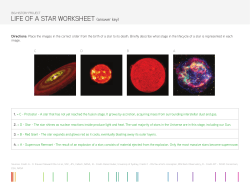
Test - Hampton Science 8A 8B 8C 8D 8E Stars are classified on the
Test - Hampton Science 8A 8B 8C 8D 8E 1. Galaxies are best described as A. rare in the universe. B. always spherical in shape. C. clusters of billions of stars. D. clouds of gases around stars. 2. Stars are classified on the Hertzsprung - Russell diagram according to their absolute magnitude and their surface temperatures at a given time in a star’s life cycle. What classification would a star have if it was very hot and very bright? F. G. H. J. Main Sequence White Dwarf Supergiant Giant 3. Stars in the universe are classified on the Hertzsprung – Russell Diagram as a tool to help astronomers determine the life stage of a star. What is one limitation when using this tool? A. B. C. D. 4. The diagram does not show the approximate age of a star. A star’s surface temperature is not always determined by its color. Many stars found in the universe are not included on the diagram. The diagram was designed incorrectly because the surface temperature should increase not decrease when moving left to right. The Milky Way galaxy is described as a disk of stars orbiting a central point on the disk. Which of these best explains why people on Earth cannot see the entire shape of the Milky Way? F. Earth is a part of this galaxy. G. Many more stars exist outside the galaxy. H. The stars in the center of the galaxy are extremely small. J. The center of the galaxy consists of a dense cluster of stars. 5. The Hertzsprung-Russell diagram below shows how the brightness, surface temperature,and color of stars are related. Which of these observations of Barnard’s Star is most likely accurate? 6. A. Barnard’s Star is less bright than the sun, has a surface temperature below 3,800 K, and is red. B. Barnard’s Star is less bright than the sun, has a surface temperature above 3,800 K, and is red. C. Barnard’s Star is brighter than the sun, has a surface temperature below 5,300 K, and is yellow. D. Barnard’s Star is brighter than the sun, has a surface temperature above 5,300 K, and is yellow. Most stars in the universe are part of a galaxy. Which statement would identify our Sun’s placement in our galaxy? F. The Sun can be found in the center of the galaxy because it is the center of our solar system. G. The galaxy, which our sun is a part of, is disc-shaped; the sun is found near the outer edge. H. Our Sun is part of a circular galaxy and it is found on the outer edge. J. The Sun, like other stars in our galaxy, can be found close to a bulge in the center. 7. 8. 9. Why does Earth get more energy from the sun than from all the other stars in the universe combined? A. The sun is much larger than the other stars. B. The sun is much hotter than the other stars. C. The sun is much more dense than the other stars. D. The sun is much closer than the other stars. The sun is a medium-sized star that sits at the edge of the Milky Way Galaxy. Which of the following diagrams correctly demonstrates the shape of the Milky Way Galaxy? F. A. G. B. H. C. J. D. A light-year is defined asA. the distance from Earth to the Sun. B. the distance from Earth to Alpha Centauri. C. the distance light traveled in one day. D. the distance light travels in one year. 10. The stars in the universe, except the Sun, are very far away. The distance from Earth to a star is determined using the measurement of light years. Since the Sun’s light only takes about eight minutes to reach Earth, then the other stars’ light can take many years before it is visible to people on Earth. What is a dilemma when considering the light coming from a star that is 40 light years away from Earth? F. G. H. J. Many stars a lot closer to Earth than 40 light years so their light waves will reach Earth faster than the Sun. The absolute magnitude of a star that is 40 light years away would be very dim to the people on Earth. All stars are 40 light years away because their sizes, in the sky, are all the same as we observe them. A star that is 40 light years away could already be deceased before its light reaches Earth. 11. The picture shows sand used to make a model of a galaxy. In the model, each grain of sand best represents — A. a comet B. a black hole C. an asteroid D. a star 12. List the three sub-atomic particles. 13. 14. 15. Which element makes up most of the matter in universe? 16. What is it’s atomic number (answer to question # 15)? 17. How many Protons does it have (answer to question #15)? 18. Which element is the second most abundant in the uninverse? 19. What is it’s atomic number (answer to number 18)? 20. How many protons does it have(answer to number 18)? 21. Name the common Isostope of Hydrogen that contains one Neutron. 22. Which celestial body creates all of the elements “heavier” than Hydrogen? 23. Identify the process that creates “heavier” elements out of “lighter” elements. 24. Identify the force that drives fusion. 25. Identify the Latin word for cloud. 26. Name the galaxy that we occupy. 27. Classify the shape of the galaxy that we occupy. 28. Locate our Sun within its galaxy—are we nearer the center or the edge? 29. Which Star is closest to our Earth? 30. We use the mean distance between the Earth and the Sun as a unit of measurement. What is the name of this unit of measurement? 31. Place the following items in order of ascending mass: Asteroids, Stars, Planets, Galaxies, Electrons, Neutrons, Dust, Protons 32. 33. 34. 35. 36. 37. 38. 39. In addition to the items on the list above (in #31), what celestial item would be classified (by mass) between the masses of Planets and Galaxies? 40. In addition to the items on the list above (in #31), what celestial item would be classified (by mass) between the masses of Dust and Planets? 41. Which item on the following list is a part of the Electromagnetic Spectrum? (Visible Light, Dust, Deutrium) 42. Which part of the Electromagnetic Spectrum carries higher energy? (X-Rays, Visible Light, Infrared) 43. Which part of the Electromagnetic Spectrum carries higher energy? (Ultraviolet, Infrared, Microwaves) 44. Identify the acronym that describes the Visible Light part of the Electromagnetic Spectrum. 45. Explain why Fusion occurs in Stars and why it doesn’t occur in Planets and Nebulae. 46. 47.
© Copyright 2025










